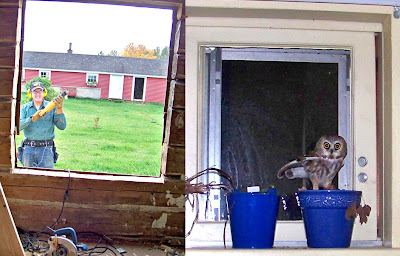I don’t know who owns the humble log structure, but I sure know I enjoy pretending it’s me from time to time. And I know there are dozens of others who feel the same way.
It’s a cabin on a bedrock bald overlooking a frozen lake in the highlands of the central Upper Peninsula. And we’re an interloping band of roving cabin poachers. Good people, mostly, I think, but not afraid to bend the rules occasionally, now and again, from time to time and over and over. We hold fast to the belief, often found in areas with high unemployment and low wages, that it’s a damn shame when certain things go unused or underappreciated. Oak saw logs that didn’t make it onto the logger’s truck become our firewood. Fender-tenderized venison fills our freezers. Abandoned, or, um, lightly used camps and cottages fill our weekends.
Now, if you’re still reading, and not dialing the authorities, you’ll be happy to know that while what we do is technically…probably…okay, most likely breaking and entering, there has never been any breaking. In fact, there’s often fixing. I don’t know what the sentence for entering and repairing would be, but up here common law and common sense seem more common place, and I’m willing to bet that a judge in Ishpeming or Eagle River would go easy on us.
I’ve heard that the owners are in Texas, or was it Florida? Anyway, they’re someplace warm and far away. I guess they own several hundred acres enrolled as commercial forestland, and probably managed as part of an investment portfolio. I wonder if they’ve ever even seen this rugged pocket of lakes and hills, a good hike in off a dirt road that only connects to another dirt road? What are the odds that they’ve pushed through blowdowns, mucked around impromptu beaver ponds and scaled the massive rock up to the shack?
Just for argument’s sake, let’s say they did make it this far, scrubbed a little circle in the frosty window pane, and peeked in at the generations of candles on the table, wood stacked along the back wall and a collection of red and white canned goods on the shelf. Would they be upset that their abandoned cabin, was being well cared for? In disbelief, would they reach out for the padlock on the front door and realize, like we had, that it was indeed locked, but not actually attached to the door?
If they stepped in they’d find fishing poles in the corner from the cabin’s trout-seeking summer friends. Winter guests, like us, have jammed cracks and crevices with insulation, while steel cables in the rafters keep the sagging old walls from splaying out under a staggering snowload. Tar dabs patch the ceiling like inky stars.
I’d be proud to take credit for all the improvements, but most of them appear to have been made by our anonymous poaching compatriots over several decades. The truth is, my friends and I have only known about the place for a few years. It started when a friend heard a rumor, about a rumor, about a cabin back in the hills. Another friend had a government job combing aerial photos day-in and day-out, mapping soils or looking for boogey men or something. We soon convinced him to put his technical skills to work surfing for our hobo realestate.
Since then our eye-in-the-sky guy has constantly been on the hunt for new prospects. He starts with public lands, or at least lands with public access, then looks for structures, or even just those familiar squares of cleared homesteads that hint a building might still remain. If the access roads are overgrown, it’s a good bet that nobody owns it, or at least nobody will care if we pretend we do. Then it’s into the bush for some old-fashioned map and compass work.
Most of his finds have just been piles of rotting logs framing the hulk of a stove or tangle of an old bed spring. Some were obviously private, and we moved on…after a little peek. One was obviously private, but a guest book made it clear that strangers were welcome. Few are locked.
The ornery old pot-bellied stove is purring now, finally roused from its January slumber. We shed wool and down, watching waves of lake effect snow wash across the valley. It would be quaint to think of this as a charming weekend in a sparkling snow globe. But this is the highlands, where Lake Superior storms tear their bellies open on forested slopes, spilling snow in amounts only quantifiable with body parts: knee, hip, and chest deep. If we’re in a snowglobe, then it’s one that’s been duct taped to a runaway snowshoe hare.
At the cabin, talk often turns to pooling our scraped-up resources for a little piece of land somewhere way back, far in and high up. Maybe we’d clear a rough trail to get supplies in, but once the place was built, we all agree the road should be abandoned in favor of a foot trail. We call it a snowshoe cabin. Just a place to get warm and dry. A winter basecamp, like the one we’re in now—but actually ours. I don’t know if it’ll ever happen, but if it does, you can bet the shelves will be stocked, firewood cut, and the door open.




























